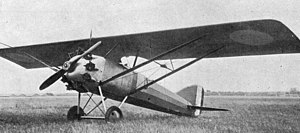
The Amiot 143 was a late 1930s French 5-seat Multiplace de Combat (M.5) designed to meet 1928 specifications for a monoplane capable of day and night bombing, long-range reconnaissance and bomber escort.

The Bloch MB.210 and MB.211 were the successors of the French Bloch MB.200 bomber developed by Société des Avions Marcel Bloch in the 1930s and differed primarily in being low wing monoplanes rather than high wing monoplanes.

The Bloch MB.170 and its derivatives were French reconnaissance bombers designed and built shortly before the Second World War. They were the best aircraft of this type available to the Armée de l'Air at the outbreak of the war, with speed, altitude and manoeuvrability that allowed them to evade interception by the German fighters. Although the aircraft could have been in service by 1937, debate over what role to give the aircraft delayed deliveries until 1940.

The Farman F.220 and its derivatives were thick-sectioned, high-winged, four engined monoplanes from Farman Aviation Works. Based on the push-pull configuration proven by the F.211, design started in August 1925 and the first flight of the prototype was on 26 May 1932. The definitive F.222 variant was the biggest bomber to serve in France between the world wars. One variant was designed as an airliner.
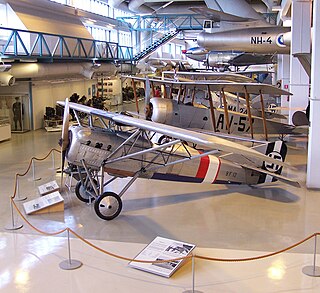
The Gourdou-Leseurre GL.2 was a French fighter aircraft which made its maiden flight in 1918.

The Bréguet 390T, 392T and 393T were a family of French propeller-driven sesquiplane airliners of the mid-1930s.

The Gourdou-Leseurre GL-812 HY was a 3-seat reconnaissance floatplane, built by Gourdou-Leseurre.

The Gourdou-Leseurre GL-832 HY was a 1930s French light shipboard reconnaissance floatplane designed and built by Gourdou-Leseurre for the French Navy.
The Gourdou-Leseurre Type A, retrospectively named the GL.1, was a prototype fighter aircraft built in France in 1918. It was a conventional parasol-wing monoplane with fixed tailskid undercarriage, with main units connected by a cross-axle. The pilot sat in an open cockpit. Construction was of fabric-covered wood and steel. Initial flight testing revealed performance superior to most contemporary biplane fighters and led to an order of 100 aircraft being placed. However, further tests suggested that the aircraft structure could be considerably lightened, and that the wing needed to be stiffened, leading to a cancellation of the order.
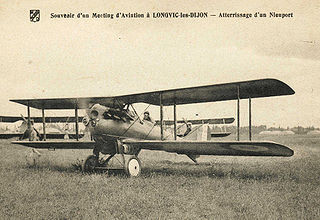
The Nieuport-Delage NiD.29 was a French single-seat biplane fighter designed and built by Nieuport-Delage for the French Air Force.
The Renard Epervier was a Belgian prototype single-seat all-metal fighter monoplane designed by Alfred Renard at the Societé Anonyme Avions et Moteurs Renard for a government-sponsored design contest in 1928. The Epervier Type 2 was built and flown in 1928, by Belgian aircraft manufacturer Stampe et Vertongen. It carried an armament of two synchronised 7.7mm guns and was lost in September 1928 after failing to recover from a flat spin. A second prototype, the Epervier Type 2bis, introduced revised streamlined fairings for the cantilever mainwheel legs, mainwheel spats and cylinder aft-fairings and was built by SABCA.

The SNCASE SE.100 was a French two-seat, twin-engined fighter that first flew in 1939. Mass production was planned to begin late in 1940 but the Fall of France prevented this.
The Gourdou-Leseurre GL.50, also known as the Gourdou-Leseurre Type F, was a French fighter prototype of the early 1920s.
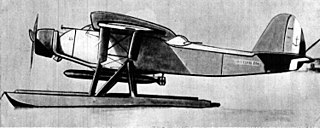
The Latécoère 290 was a torpedo bomber floatplane produced in France during the 1930s. Designed by Latécoère in response to an Aéronavale specification for such an aircraft, the 290 was based on its successful Laté 28.3 mail plane. It was a conventional high-wing, strut-braced monoplane that carried a single torpedo externally under the fuselage.

The Levasseur PL.10 was a carrier-based reconnaissance aircraft developed in France in the late 1920s. It was a conventional, single-bay biplane along similar lines to Levasseur's contemporary designs for the French navy, including a watertight, boat-shaped fuselage, small underwing floats, and undercarriage that could be jettisoned in flight in order to improve the changes of a successful ditching.
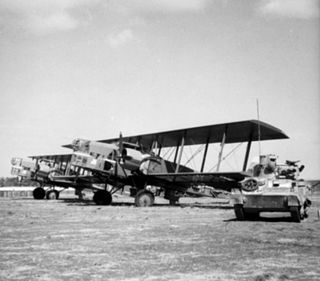
The Lioré et Olivier LeO 25 was a bomber aircraft produced in France in the late 1920s.

The Villiers II was a French two-seat fighter aircraft of the 1920s intended for operation from the Aircraft carrier Béarn of the French Navy. It was a single-engined tractor biplane with a waterproof hull in the form of a flying boat to allow the aircraft to be safely landed on water in an emergency. Two prototypes and 30 production aircraft were built, the type serving briefly with the French Navy, although never operated from an aircraft carrier.
The Bréguet 482 was a French four-engined heavy bomber aircraft designed just prior to the outbreak of the Second World War with two prototypes nearing completion when Germany invaded France in 1940, one of which was flown after the end of the war as an experimental platform.

The Hanriot HD.15 was a French two seat fighter aircraft fitted with a supercharger for good high altitude performance, built in the 1920s. Three were ordered by Japan but lost at sea during delivery.
The Gourdou-Leseurre GL-820 HY family of four-seat single-engined floatplanes were designed and built in France during the latter half of the 1930s by Gourdou-Leseurre. The GL-820 HY and GL-821 HY 02 were shipborne reconnaissance / observation aircraft, while the sole GL-821 HY was built as a torpedo carrier.
